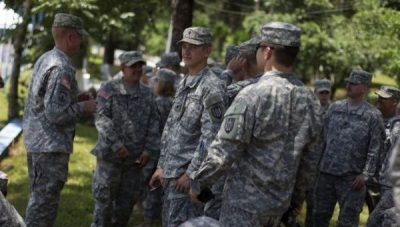The US’ Official View of “Strategic Rivalry” in the Western Hemisphere. The Chinese Threat to US Hegemony

The Commander of US SOUTHCOM shared the US’ official view of strategic rivalry in the Western Hemisphere last week when speaking before the Senate Armed Services Committee’s Emerging Threats subcommittee, revealing that his country considers China to pose the greatest threat to its interests while simply dismissing Russia as a “spoiler” despite its much more heavily publicized involvement in the region.
The New Cold War has spread to the Western Hemisphere in recent years despite the rapid success of Trump’s “Fortress America” strategy for restoring the US’ uncontested hegemony over this half of the world. Although many of the “Pink Tide” governments of the 2000s have since fallen as a result of “Operation Condor 2.0‘s” Hybrid War regime changes that were carried out via “constitutional coups” and other underhanded methods such as as the actual US-backed coup that took place in 2009 Honduras, the socialist ones in Venezuela, Nicaragua, and Cuba (the so-called “Troika of Tyranny“) that still remain provide strategic points of access for America’s Chinese and Russian adversaries. Furthermore, the People’s Republic has made impressive advancements in courting many otherwise pro-US states to join its Belt & Road Initiative (BRI), thus representing the most serious competition in the region since the spread of communism during the Old Cold War.
The Commander of US SOUTHCOM insightfully shared the US’ official view of this strategic rivalry in the Western Hemisphere last week when speaking before the Senate Armed Services Committee’s Emerging Threats subcommittee, revealing that his country considers China to pose the greatest threat to its interests while simply dismissing Russia as a “spoiler” despite its much more heavily publicized involvement in the region. The reason for this is clear, and it’s that the US is concerned that China will instrumentalize its economic influence in the region for political, military, and ultimately strategic ends, strongly hinting that BRI is its backdoor for replacing America’s control over these many countries’ permanent military, intelligence, and diplomatic bureaucracies (“deep states”), something that Russia’s “shows-of-force” are incapable of doing. According to Admiral Craig Faller, Beijing’s over 50 port projects could conceivably be used for military logistics functions even though he failed to mention even a single scenario where this could realistically occur.
Together with the spread of Chinese information-communication technologies (Huawei-driven 5G and its related “Smart And Safe Cities” initiative) that he says will make it more difficult for the recipient nations to cooperate with the US in this sphere and the no-strings-attached approach to security cooperation, the US SOUTHCOM chief thinks that the People’s Republic is luring the regional states away from the US. He’s also worried about what he described as his premier rival’s “uneven capacity and will to stop illegal shipments” of fentayl, which he implies is being deliberately exported to the Western Hemisphere with the grand strategic intent of flooding the American marketplace and killing its citizens through unconventional means. By comparison, Admiral Faller thinks that Russia is all bark and no bite, prioritizing so-called “disinformation” campaigns and military diplomacy but achieving close to nothing in practical terms except for helping the Venezuelan government resist the US’ regime change efforts.
If there’s one country besides Venezuela to watch, however, it’s Nicaragua, in which he says Russia has been successful in creating a “Counter Transnational Organized Crime Training Center (CTOC) that could “potentially provide Moscow with a regional platform to recruit intelligence sources and collective information”. Conspicuously left out of this threat assessment briefing is the legacy of the US’ Old Cold War-era conflicts in Central America that set the structural basis for regional state failure and these governments’ susceptibility to the same corruption that he accuses China and Russia of exploiting. Nor, for that matter, does he make any mention of the threat posed by “Weapons of Mass Migration” emanating from this region for those very same reasons that the US is ultimately responsible for, especially in the contemporary context of the ongoing Honduran Crisis caused by his country’s support for its unpopular strongman. This glaring omission confirms that Admiral Fuller’s briefing is heavily politicized and thus fails to address the root causes of the US’ security challenges there.
The military official’s suggested solutions are also bereft of substance, too. While parroting the popular catchphrase of a “whole-of-government approach”, he fails to elaborate on exactly what this should entail. Instead, he simply spoke in very general terms about the importance of strong partnerships, emphasizing the need for “engagements and presence”, “information & intelligence sharing” (curiously in spite of his prospective partners’ information-communication cooperation with China that he earlier said could preclude this very development from happening for “security” reasons), and “education and training” (with the mentioning of the School of the Americas-rebranded “Western Hemisphere Institute for Security Cooperation” hinting at a will to once again assemble death squads). If that’s all that the US plans to do to counter China’s economic attractiveness and Russia’s behind-the-scenes “democratic security” support, then “Fortress America” might fall before Trump has any idea what happened.
*
Note to readers: please click the share buttons above or below. Forward this article to your email lists. Crosspost on your blog site, internet forums. etc.
Andrew Korybko is an American Moscow-based political analyst specializing in the relationship between the US strategy in Afro-Eurasia, China’s One Belt One Road global vision of New Silk Road connectivity, and Hybrid Warfare. He is a frequent contributor to Global Research.

